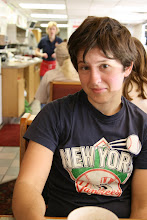 A new friend, Claire Kessler-Bradner, went to the same college as me (though we never met-- she was a senior when I was a wee freshman) and now we are enrolled in the same graduate program together. We also make very different art about very similar subjects: grieving, family, home, love, community, identity. Our fathers are both editors, too. A couple of weeks ago Claire told me that her father has a theory that the concept of a perfect translation is impossible-- that there is no way to translate a text without losing nuances and motives of the original. Her father translates poems and texts, while my father edits ecological manuscripts, so I hadn't really thought of editing as a process of loss, but more as a process of bettering and a pursuit of coherency.
A new friend, Claire Kessler-Bradner, went to the same college as me (though we never met-- she was a senior when I was a wee freshman) and now we are enrolled in the same graduate program together. We also make very different art about very similar subjects: grieving, family, home, love, community, identity. Our fathers are both editors, too. A couple of weeks ago Claire told me that her father has a theory that the concept of a perfect translation is impossible-- that there is no way to translate a text without losing nuances and motives of the original. Her father translates poems and texts, while my father edits ecological manuscripts, so I hadn't really thought of editing as a process of loss, but more as a process of bettering and a pursuit of coherency.I realized, that to some extent, even the translation I practice daily, of the visual torrent in my head to a coherent one on paper, is fraught with inevitable failure too. I can never make things look as I see them in my head, just as I can never tell a story exactly how it happened. But of course, I'm talking about a failure without the negative baggage the word generally implies-- failures, I'm learning over and over again, are critical to the process of learning. I recognize that this is probably reading like some sort of silly art-school epiphany. The concept is really quite simple: there exists a divergence between reality (the subjective lens) and truth (the objective lens).
I love these pictures-- two of many chemically distorted Polaroid images in my collection. Polaroid has discontinued their film, and a small company in Germany (I hear) has publicly promised to pick up the films manufacture. I like how the ruin of these prints simultaneously frames and confuses the composition. Also, the colors of those stains are just really rich and lovely and early 1980's-- chemical hazels and violets like you see when car oil floats in rain puddles.

No comments:
Post a Comment